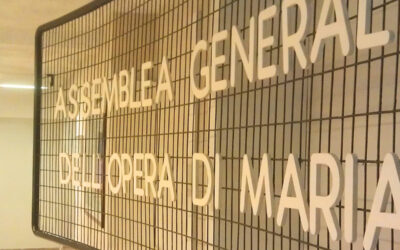 “For several years I had become hard, closed up on myself, sad; today Chiara Luce has opened my doors” one of the convicts tells Maria Teresa, mother of the blessed Chiara Luce Badano, while he embraces her and holds her hands.
“For several years I had become hard, closed up on myself, sad; today Chiara Luce has opened my doors” one of the convicts tells Maria Teresa, mother of the blessed Chiara Luce Badano, while he embraces her and holds her hands.
The 20th September was certainly a special afternoon, in the theatre of the Rebibbia Roman prison: 250 inmates were dressed in their best clothes to greet the couple, Ruggero and Maria Teresa Badano, parents of the blessed Chiara Luce. “It will be a special evening,” Anna Del Villano announces in her presentation. She is the director of one of the sectors of the prison.
How did all this come about? Alfonso Di Nicola, of the Focolare Movement, who has for many years carried out voluntary work in the prisons of Rebibbia: “I got to know that the Badanos visited the convicts in the Viterbo prison in 2011,” he relates,“and I thought that we could organise a similar evening also in Rebibbia.”
While the inmates find their seats, it is impressive to see how they greet each other warmly. They come from different sections of the prison, “according to the crime committed,” they explain.
 Four people sat on the stage: the Badanos, Chicca Coriasco – a close friend of Chiara Luce – and Franz, her brother. Maria Teresa breaks the ice and recalls how much her daughter loved the sick and those who suffer, and invites all to share this moment as in a family. Ruggero does not hide his emotions.
Four people sat on the stage: the Badanos, Chicca Coriasco – a close friend of Chiara Luce – and Franz, her brother. Maria Teresa breaks the ice and recalls how much her daughter loved the sick and those who suffer, and invites all to share this moment as in a family. Ruggero does not hide his emotions.
What is Chiara Luce’s message? She was a normal girl who played sport; she loved Sassello, her native city, especially when it was covered with snow. Together with Chicca, she got to know the Focolare spirituality when she was still very young. They took up Chiara Lubich’s invitation to live the Gospel with youthful enthusiasm, in the diverse situations of everyday life, both joyful and sorrowful; and then they would share the fruits of their experiences in order to encourage each other.
“As it is with older brothers,” Franz quips in, “I kept myself aloof from them.” She was a normal girl, and it was precisely this normality that drew him to her, especially when her illness would eventually be diagnosed as terminal cancer. Franz continues, “Chiara Luce was in love with Jesus crucified in the way Chiara Lubich presented him: abandoned, “a loser”, a “conquered God” who resembles each one of us… who at a certain point cries out on the cross”.
Love for God was the secret that helped her live her grave illness – an osteosarcoma, a very aggressive tumour. Through him her every suffering was transformed into love with contagious serenity and joy. Ruggero relates: “I used to spy upon her from the keyhole of her room to see whether she was always like that, or whether her smile was only for us. But she smiled all the time.”
 The silence in the theatre is not usual. Chiara Luce’s story captures the attention of all and this young girl enters the heart of those present. While some images of Chiara Luce were projected on a big screen, an international Focolare choir sang “God Loves Me”, the song written for the beatification of Chiara Luce, on 25th September 2010.
The silence in the theatre is not usual. Chiara Luce’s story captures the attention of all and this young girl enters the heart of those present. While some images of Chiara Luce were projected on a big screen, an international Focolare choir sang “God Loves Me”, the song written for the beatification of Chiara Luce, on 25th September 2010.
“Soon Chiara Luce will be a saint” one of the inmates exclaims. Maria Teresa replies: “Then you will no longer be here… we all pass through difficult periods”. Her words fall like balm and are greeted with a warm applause!
Official website of the postulation: www.chiaralucebadano.it
Chiara Luce Website “Life Love Light”: www.chiaraluce.org
Franz Coriasco, author of “Dai tetti in giu”, Ed. Citta Nuova, Roma 2010




0 Comments